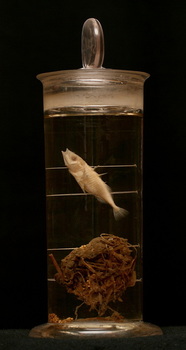Fish
|
Fish are cold-blooded vertebrates found in the world’s fresh and salt waters. Their bodies are generally fusiform (tapered to each end) with paired fins and covered by skin adorned with either bony or toothlike (placoid) scales. Respiration is generally through gills. Most fish also have a swim bladder, a gas-filled organ used to adjust swimming depth.
The museum houses a range of living species, from the primitive, jawless lampreys and hagfishes through the cartilaginous sharks, skates and rays to the abundant and diverse bony fishes. The collection also includes a number of fossils and casts of the prehistoric fish that lived in the sea during the Devonian period (415-360 million years ago), a period best known for its abundance and diversity of fish. |



